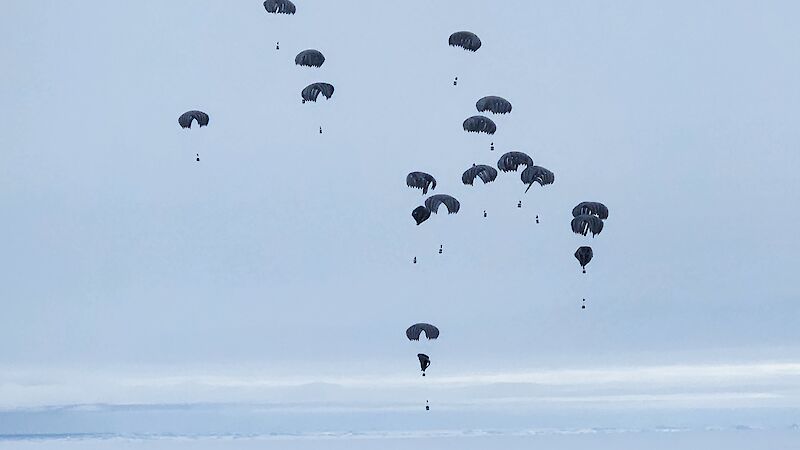More than 600 kg of ice core drilling supplies have been airdropped to Casey station in preparation for the Million Year Ice Core (MYIC) project summer drilling season.
The supplies included flatpack benches, rubber flooring mats, ice core trays, driller suits, mechanical parts and frozen food.
They were part of a nine tonne delivery of station supplies, including fresh food and medicines, dropped by a Royal Australian Air Force C-17A Globemaster III, from 1500 metres.
The airdrop officially kick-started the 2025-26 season for 'Operation Southern Discovery' - the Australian Defence Force's contribution to the Australian Antarctic Program's scientific and logistic capabilities.

Million Year Ice Core project Science Lead, Dr Joel Pedro, said the airdrop and other logistic support was critical to the project's success in drilling the longest, continuous ice core record of Earth's past climate and atmospheric composition.
"The one to two million years of climate information that this ice core will provide will improve understanding of long-term climate and ice sheet stability and aid in testing climate models," Dr Pedro said.
Director of the Australian Antarctic Division's Operations Management Centre, Mr Simon Owen, said the airdrop was the first step in a "three-phase approach" to supporting the MYIC project.
The second phase involves a fly-off from RSV Nuyina to Casey station, of additional drilling equipment, sensitive scientific instruments, and the 10-person tractor-traverse team, who will haul everything 1200 km 'uphill' to the drill site at Dome C North.
Phase three involves delivery of a four tonne ice core drill winch, and associated deep ice core drilling equipment, to the French station Dumont D'Urville, on the L'Astrolabe.
The winch will then travel by French traverse to the Australian ice-core drilling site.
"The airdrop, together with the Casey fly-off will enable Australia's traverse team to de-winterise the tractors and other plant and equipment, and depart Casey approximately four weeks earlier than would ordinarily be available via other logistics pathways," Mr Owen said.
"All things going to plan, the drill winch will arrive at Dome C North shortly after they do."
Dr Pedro said the phased delivery ensured equipment could be pre-positioned prior to the arrival of the eight*-person team of ice core scientists and drilling engineers in late November.
"The multiple pathways for getting cargo to the drill site this season, aim to safely deliver our equipment at the right time to support two months of science and ice core drilling," Dr Pedro said.
"There is narrow window of opportunity from late November to late January when conditions are warm enough to work at the site, which sits over 3200 metres above sea level.
"Outside this period temperatures drop below -50 to -60°C and it is not possible to work, or logistically support operations, at the remote location."
Last season the traverse and scientific drilling teams spent a month at Dome C North.
They installed a large drilling shelter, tested and trouble-shot their ice-core drilling equipment under extreme conditions, and drilled 150 metres of a planned 3000 metres into the ice sheet.
The recovered ice cores are now being analysed at Australian Antarctic Program laboratories in Hobart.
The team also conducted geophysical surveys at the site to refine their understanding of the physical properties of deep ice.
"This season a lot of our work will involve setting up our big, cable-suspended, electro-mechanical drill, which can reach 3000 metres-deep and tolerate the -55˚C temperature in the ice," Dr Pedro said.
"The Australian Antarctic Division has spent nearly six years developing this new drilling system, in collaboration with other international research groups.
"We'll aim to drill 400 metres this season. After that, the target is to drill 1000 metres per year, which will put us on track to reach bedrock by 2029."






